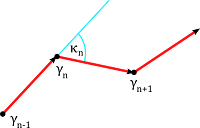Let $(\gamma_0,\ldots,\gamma_n)$ be a regular polygon in the plane $\mathbb{R}^2$. Then there are unique real numbers $\ell_0, \ldots ,\ell_{n-1}>0$ and unit vectors $T_0,\ldots,T_{n-1}\in S^1$ such that the edge vectors of $\gamma$ have the form
\[\gamma_{j+1}-\gamma_j=\ell_j T_j.\]
Furthermore, it never happens that $T_{j+1}=-T_j$ and therefore there are unique real numbers $\kappa_1,\ldots,\kappa_{n-1}$ such that
\begin{align*}-\pi &< \kappa_j < \pi \\\\ T_j &= e^{i\kappa_j}\,T_{j-1}.\end{align*}
 It is easy to see that we have
It is easy to see that we have
\[T_j=e^{i\alpha_j}\,T_0\]
with
\[\alpha_j=\sum_{k=1}^j \,\kappa_j.\]
So $\kappa$ determines $T$ uniquely up to a multiplicative constant $a=T_0$ of norm one. Together with the edge lengths $\ell_0,\ldots, \ell_{n-1}$ the tangent directions $T$ in turn determine $\gamma$ up to an additive (translational) constant $b=\gamma_0$:
\[\gamma_j=\gamma(0)+\sum_{k=0}^{j-1}\, T_j.\]
Thus for each collection of edge length $\ell_0,\ldots, \ell_{n-1}$ and each curvature function $\kappa$ there exists a discrete curve $\gamma$ with curvature $\kappa$. Every other such curve $\tilde{\gamma}$ differs from $\gamma$ only by a euclidean motion:
\[\tilde{\gamma}=a \gamma+b\]
with $|a|=1$.
For a closed discrete curve we must have $T_n=T_0$ which means that there has to be an integer $m\in \mathbb{Z}$ such that
\[\sum_{k=1}^n\, \kappa = \alpha_n=2\pi m.\]
$m$ is called the tangent winding number of $\gamma$.
